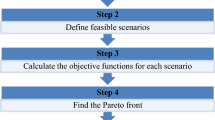Abstract
In line with growth and sustainable development of the country and fundamental evolution of economic and social matters, the role of road networks becomes ever more significant. The network provides access to hot spots and movement of materials which are necessary for such a development. To address sustainable road development, GIS techniques were used to determine the optimum routes. All important parameters like slope, geology, landslide, etc. were selected, collated in a data base and used to create a cost layer. Then, using the Least Cost Pathway Algorithm, the four routes based on different cost layers were designed in GIS. These cost layers were calculated based on variable threshold values related to each criterion. Finally the optimum way was selected according to distance from landslide zone, fault lines, high slope areas and proximity to economical centres. As conclusion and in comparison, we found that currently designed road without regard to environmental factors may lead to selection of ways that will pass through inhibited zones increasing the likelihood of damage to the environment and economical costs.








Similar content being viewed by others
References
Bannister, D. (2002). Untitled Editorial introduction. Journal of Transport Reviews, 22(2), 133–135.
Berry, J. K., King, M. D. & Lopez, C. (2004). A web based application for identifying and evaluating alternative pipeline routes and corridors. GITA Oil and Gas Conference proceeding. Houston, Texas. Available online at: www.innovativegis.com/basis/present/gita…/GITA_Oil&Gas_04.pdf
Collishon, W., & Pilar, J. V. (2000). A direction dependent least cost path algorithm for roads on canals. International Journal of Geographical Information Science, 14(4), 397–406.
Douglas, D. (1994). Least cost path in GIS using on accumulated cost surface and slope lines. Journal of Cartographical, 31(3), 37–51.
Eastman, J. R. (2006). IDRISI Andes Guide to GIS and Image Processing. Worcester: Clarke Labs, Clarke University.
Ebrahimpoor, A. R., Alimohamadi, A., Alesheikh, A., & Aghili, H. (2009). Routing of water pipeline using GIS and genetic algorithm. Journal of Applied Sciences, 9(23), 4137–4145.
ESCAP. (2000). Road development and the environment: methodology for minimizing environmental damage. Economic and Social Commission for Asia and the Pacific. New York: United Nation publication.
Esri. (2007). ArcGIS 9.2 Help, Online Manual. Environmental System Research Institute Inc. Redlands, Colifornia. Available online at: http://webhelp.esri.com/arcgisdesctop
Feldman, S. C., Pelletier, R. E., Walser, E., & Smoot, J. C. (1996). Remote sensing, GIS, analysis used in selecting potential line route. Journal of Pipeline Gas Industry, 79(5), 52–55.
Ghosh, J. K., & Suri, S. (2005). A knowledge based system for assessment of landslide hazard. In Proceedings of the Indian Geotechnical Conference, IGS, Ahmedabad, India, 1, 393–396.
Gutierrez, Z. G., & Rubio, O. A. (2004). Quantitative assessment for selecting the route for a gas pipeline in Yucatan, Mexico. Journal of Human and Ecological Risk Assessment, 10(2), 451–460.
Humber, J. (2004). Enhancing the Pipeline route Selection Process. GITA Oil & Gas Conference Proceedings. Available online at: http://www.gisdevelopment.net/proceedings/gita/oil_gas2004/papers/09gos2004.pdf
Iranian Plan and Budget Organization (2007). Office of Deputy for Technical Affairs. Bureau of Technical Affairs and Standards. Iranian Plan and Budget Publication in Golestan Province.
Keshkamat, S. (2007). Formulation & evaluation of transport planning alternatives using multi criteria assessment and network analysis. M.Sc. Thesis. International Institute for Geo-information Science and Earth Observation. Netherland.
Kim, H., Lee, D., Koo, J., & Park, H. (2011). The direct employment impact analysis of highway construction investments. Journal of Civil Engineering, 16(6), 958–966.
Lai, T. (2011). Modeling spatial dynamics of landslides: integration of GIS-based cellular automata and multi criteria evaluation methods. M.Sc. Thesis, Department of Geography, Simon Fraser University.
Lee, J., & Stucky, D. (1998). On applying view shed analysis for determining least cost paths on digital elevation models. International Journal of Geographical Information Science, 12(8), 891–905.
Malczewski, J. (2004). GIS-based land-use suitability analysis. Journal of Progress in Planning, 62(1), 3–65.
Malczewski, J. (2006). GIS-based multi criteria decision analysis: a survey of the literature. International Journal of Geographical Information Science, 20(7), 703–726.
Miller, H. J., & Shaw, S. L. (2001). Geographic information system for transportation. Principles and applications (p. 458). New York: Oxford University Press.
Primahardhika, F. (2007). Determination of the Transjakarta Busway Gas Pipeline Using Geographic Information System and Multi criteria Decision Making. Master Thesis, Bogor Agricultural Univ, Science in Information Technology for Natural Resource Management, Indonesia.
Rudolph, G. (1994). Convergence analysis of canonical genetic algorithms. Journal of IEEE Transaction, 5(1), 96–101.
Saaty, T. L. (1980). The Analytical Hierarchy Process. New York: McGraw Hill.
Stefanakis, E., & Kavouras, M. (1995). Determination of the optimum path on the earth surface. Proceeding 17th International Cartographic Association Conference, Spain, pp: 268–282.
Tan, B. K. (2005). Engineering geology of rock slopes in highway construction, 2nd Quarter 2005 cover story 22. Malaysia: University Putra Malaysia Press.
Yu, C., Lee, J., & Munro Stasiuk, M. J. (2003). Extensions of least cost path algorithms for roadway planning. International Journal of Geographic Information Science, 17(4), 361–367.
Acknowledgments
We would like to thank Omid Abdi and Meyssam Mottaki for the scientific discussions and suggestions. We are also grateful to members of the Department of Fisheries and Environmental Science for their help in collecting data.
Author information
Authors and Affiliations
Corresponding author
About this article
Cite this article
Mahini, A., Abedian, S. Routing of Road Network through Least Cost Pathway Algorithm to Minimize Impacts on Environment. J Indian Soc Remote Sens 42, 517–527 (2014). https://doi.org/10.1007/s12524-013-0351-7
Received:
Accepted:
Published:
Issue Date:
DOI: https://doi.org/10.1007/s12524-013-0351-7




